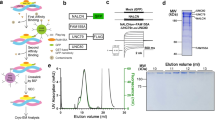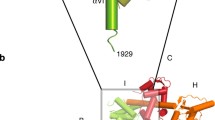Abstract
Voltage-gated sodium channels (VGSCs) are fundamental to the initiation and propagation of action potentials in excitable cells. Ca2+/calmodulin (CaM) binds to VGSC type II (NaV1.2) isoleucine and glutamine (IQ) motif. An autism-associated mutation in NaV1.2 IQ motif, Arg1902Cys (R1902C), has been reported to affect the combination between CaM and the IQ motif compared to that of the wild type IQ motif. However, the detailed properties for the Ca2+-regulated binding of CaM to NaV1.2 IQ (1901Lys-1927Lys, IQwt) and mutant IQ motif (IQR1902C) remains unclear. Here, the binding ability of CaM and CaM's constituent proteins including N- and C lobe to the IQ motif of NaV1.2 and its mutant was investigated by protein pull-down experiments. We discovered that the combination between CaM and the IQ motif was U-shaped with the highest at [Ca2+] ≈ free and the lowest at 100 nM [Ca2+]. In the IQR1902C mutant, Ca2+-dependence of CaM binding was nearly lost. Consequently, the binding of CaM to IQR1902C at 100 and 500 nM [Ca2+] was increased compared to that of IQwt. Both N- and C lobe of CaM could bind with NaV1.2 IQ motif and IQR1902C mutant, with the major effect of C lobe. Furthermore, CaMKII had no impact on the binding between CaM and NaV1.2 IQ motif. This research offers novel insight to the regulation of NaV1.2 IQwt and IQR1902C motif, an autism-associated mutation, by CaM.





Similar content being viewed by others
Data Availability
All data and models during the study appear in the submitted article.
References
Adams PJ et al (2014) Apocalmodulin itself promotes ion channel opening and Ca(2+) regulation. Cell 159(3):608–622
Asmara H et al (2010) Interactions of calmodulin with the multiple binding sites of Cav12 Ca2+ channels. J Pharmacol Sci 112(4):397
Baek JH, Cerda O, Trimmer JS (2011) Mass spectrometry-based phosphoproteomics reveals multisite phosphorylation on mammalian brain voltage-gated sodium and potassium channels. Semin Cell Dev Biol 22(2):153–159
Baek JH et al (2014) Reciprocal changes in phosphorylation and methylation of mammalian brain sodium channels in response to seizures. J Biol Chem 289(22):15363–15373
Schaller KL, Caldwell JH (2003) Expression and distribution of voltage-gated sodium channels in the cerebellum. Cerebellum 2(1):2–9
Zhang F et al (2019) BmK AEP, an anti-epileptic peptide distinctly affects the gating of brain subtypes of voltage-gated sodium channels. Int J Mol Sci 20(3):729
Feldkamp MD, Yu L, Shea MA (2011) Structural and energetic determinants of apo calmodulin binding to the IQ motif of the Na(V)12 voltage-dependent sodium channel. Structure 19(5):733–747
Mahling R, Kilpatrick AM, Shea MA (2017) Backbone resonance assignments of complexes of human voltage-dependent sodium channel NaV1.2 IQ motif peptide bound to apo calmodulin and to the C-domain fragment of apo calmodulin. Biomol NMR Assign 11(2):297–303
Lazrak A et al (2009) Alpha(1)-antitrypsin inhibits epithelial Na+ transport in vitro and in vivo. Am J Respir Cell Mol Biol 41(3):261–270
Potet F et al (2009) Functional interactions between distinct sodium channel cytoplasmic domains through the action of calmodulin. J Biol Chem 284(13):8846–8854
Han S et al (2012) Autistic-like behaviour in Scn1a+/- mice and rescue by enhanced GABA-mediated neurotransmission. Nature 489(7416):385–390
Han DY et al (2010) Calmodulin- and Ca2+-dependent facilitation and inactivation of the Cav1.2 Ca2+ channels in guinea-pig ventricular myocytes. J Pharmacol Sci 112(3):310–319
Hao LY et al (2009) The distinct roles of calmodulin and calmodulin kinase II in the reversal of run-down of L-type Ca(2+) channels in guinea-pig ventricular myocytes. J Pharmacol Sci 111(4):416–425
He G et al (2013) Lobe-related concentration- and Ca(2+)-dependent interactions of calmodulin with C- and N-terminal tails of the CaV12 channel. J Physiol Sci 63(5):345–353
Li J et al (2018) The effect of Ca(2+), lobe-specificity, and CaMKII on CaM binding to NaV11. Int J Mol Sci 19(9):2495
Kawasaki H, Kretsinger RH (2017) Conformational landscape mapping the difference between N-lobes and C-lobes of calmodulin. J Inorg Biochem 177:55–62
Miao Y et al (2010) Neuroprotective effects of ischemic preconditioning on global brain ischemia through up-regulation of acid-sensing ion channel 2a. Int J Mol Sci 11(1):140–153
Wang C et al (2014) Structural analyses of Ca 2+/CaM interaction with Na V channel C-termini reveal mechanisms of calcium-dependent regulation. Nature communications 5:4896
Hardan A, Sahl R (1997) Psychopathology in children and adolescents with developmental disorders. Res Dev Disabil 18(5):369–382
Bailey A et al (1995) Autism as a strongly genetic disorder: evidence from a British twin study. Psychol Med 25(1):63–77
Weiss LA et al (2003) Sodium channels SCN1A, SCN2A and SCN3A in familial autism. Mol Psychiatry 8(2):186–194
Maksemous N et al (2018) Whole-exome sequencing implicates SCN2A in episodic ataxia, but multiple ion channel variants may contribute to phenotypic complexity. Int J Mol Sci 19(10):3113
Ben-Shalom R et al (2017) Opposing effects on NaV12 function underlie differences between SCN2A variants observed in individuals with autism spectrum disorder or infantile seizures. Biol Psychiatry 82(3):224–232
Kim J et al (2004) Calmodulin mediates Ca2+ sensitivity of sodium channels. J Biol Chem 279(43):45004–45012
Yan H et al (2017) Calmodulin limits pathogenic Na+ channel persistent current. J Gen Physiol 149(2):277–293
Stigler J, Rief M (2012) Calcium-dependent folding of single calmodulin molecules. Proc Natl Acad Sci USA 109(44):17814–17819
Sun W et al (2014) The Ca(2+)-dependent interaction of calpastatin domain L with the C-terminal tail of the Cav1.2 channel. FEBS Lett 588(5):665–671
Tadross MR, Dick IE, Yue DT (2008) Mechanism of local and global Ca2+ sensing by calmodulin in complex with a Ca2+ channel. Cell 133(7):1228–1240
Tang W et al (2003) Apocalmodulin and Ca2+ calmodulin-binding sites on the CaV1.2 channel. Biophys J 85(3):1538–1547
Theoharis NT et al (2008) The neuronal voltage-dependent sodium channel type II IQ motif lowers the calcium affinity of the C-domain of calmodulin. Biochemistry 47(1):112–123
Minobe E et al (2011) Calpastatin domain L is a partial agonist of the calmodulin-binding site for channel activation in Cav12 Ca2+ channels. J Biol Chem. 286(45):39013–39022
Kumari SS et al (2012) Spatial expression of aquaporin 5 in mammalian cornea and lens, and regulation of its localization by phosphokinase A. Mol Vis 18:957–967
Hovey L et al (2017) Calcium triggers reversal of calmodulin on nested anti-parallel sites in the IQ motif of the neuronal voltage-dependent sodium channel NaV1.2. Biophys Chem 224:1–19
Chagot B, Chazin WJ (2011) Solution NMR structure of Apo-calmodulin in complex with the IQ motif of human cardiac sodium channel NaV15. J Mol Biol 406(1):106–119
James TF et al (1850) (2015) The Nav1.2 channel is regulated by GSK3. Biochim Biophys Acta. 4:832–844
Brachet A et al (2010) Ankyrin G restricts ion channel diffusion at the axonal initial segment before the establishment of the diffusion barrier. J Cell Biol 191(2):383–395
Brechet A et al (2008) Protein kinase CK2 contributes to the organization of sodium channels in axonal membranes by regulating their interactions with ankyrin G. J Cell Biol 183(6):1101–1114
Berendt FJ, Park KS, Trimmer JS (2010) Multisite phosphorylation of voltage-gated sodium channel alpha subunits from rat brain. J Proteome Res 9(4):1976–1984
Van Petegem F, Lobo PA, Ahern CA (2012) Seeing the forest through the trees: towards a unified view on physiological calcium regulation of voltage-gated sodium channels. Biophys J 103(11):2243–2251
Vetter SW, Leclerc E (2003) Novel aspects of calmodulin target recognition and activation. Eur J Biochem 270(3):404–414
Minobe E, Mori MX, Kameyama M (2017) Calmodulin and ATP support activity of the Cav1.2 channel through dynamic interactions with the channel. J Physiol 595(8):2465–2477
Faouzi M et al (2017) The TRPM7 channel kinase regulates store-operated calcium entry. J Physiol 595(10):3165–3180
Deschenes I et al (2002) Isoform-specific modulation of voltage-gated Na(+) channels by calmodulin. Circ Res 90(4):E49-57
Shah VN et al (2006) Calcium-dependent regulation of the voltage-gated sodium channel hH1: intrinsic and extrinsic sensors use a common molecular switch. Proc Natl Acad Sci USA 103(10):3592–3597
Pal S et al (1999) In vitro status epilepticus causes sustained elevation of intracellular calcium levels in hippocampal neurons. Brain Res 851(1–2):20–31
Tan HL et al (2002) A calcium sensor in the sodium channel modulates cardiac excitability. Nature 415(6870):442–447
Gabelli SB et al (2016) Calmodulin and Ca(2+) control of voltage gated Na(+) channels. Channels (Austin) 10(1):45–54
Pitt GS, Lee SY (2016) Current view on regulation of voltage-gated sodium channels by calcium and auxiliary proteins. Protein Sci 25(9):1573–1584
Goldfarb M et al (2007) Fibroblast growth factor homologous factors control neuronal excitability through modulation of voltage-gated sodium channels. Neuron 55(3):449–463
Laezza F et al (2007) The FGF14(F145S) mutation disrupts the interaction of FGF14 with voltage-gated Na+ channels and impairs neuronal excitability. J Neurosci 27(44):12033–12044
Lin H et al (2011) Mutation screening of three Chinese families with genetic epilepsy with febrile seizures plus. Neurosci Lett 500(2):123–128
Lee-Kwon W et al (2007) Vasa recta voltage-gated Na+ channel Nav13 is regulated by calmodulin. Am J Physiol Renal Physiol 292(1):F404–F414
Yoder JB et al (2019) Ca(2+)-dependent regulation of sodium channels NaV1.4 and NaV1.5 is controlled by the post-IQ motif. Nat Commun 10(1):1514
Sanders SJ et al (2012) De novo mutations revealed by whole-exome sequencing are strongly associated with autism. Nature 485(7397):237–241
Willsey AJ et al (2013) Coexpression networks implicate human midfetal deep cortical projection neurons in the pathogenesis of autism. Cell 155(5):997–1007
Kanner L (1968) Autistic disturbances of affective contact. Acta Paedopsychiatr 35(4):100–136
Subramanian D et al (2018) Gamma oscillatory activity in vitro: a model system to assess pathophysiological mechanisms of comorbidity between autism and epilepsy. Transl Psychiatry 8(1):16
Isbell HM et al (2018) Backbone resonance assignments of complexes of apo human calmodulin bound to IQ motif peptides of voltage-dependent sodium channels NaV1.1, NaV1.4 and NaV1.7. Biomol NMR Assign 12(2):283–289
Mori M et al (2003) Regulatory interaction of sodium channel IQ-motif with calmodulin C-terminal lobe. Biochem Biophys Res Commun 307(2):290–296
Thompson CH et al (2017) CaMKII modulates sodium current in neurons from epileptic Scn2a mutant mice. Proc Natl Acad Sci USA 114(7):1696–1701
Wingo TL et al (2004) An EF-hand in the sodium channel couples intracellular calcium to cardiac excitability. Nat Struct Mol Biol 11(3):219–225
Sarhan MF et al (2012) Crystallographic basis for calcium regulation of sodium channels. Proc Natl Acad Sci USA 109(9):3558–3563
Gade AR, Marx SO, Pitt GS (2020) An interaction between the III-IV linker and CTD in NaV15 confers regulation of inactivation by CaM and FHF. J Gen Physiol 152(2):1–25
Johnson CN et al (2018) (2018) A mechanism of calmodulin modulation of the human cardiac sodium channel. Structure 26(5):683–694
Johnson CN (2020) Calcium modulation of cardiac sodium channels. J Physiol 598(14):2835–2846
Gardill BR et al (2018) The voltage-gated sodium channel EF-hands form an interaction with the III–IV linker that is disturbed by disease-causing mutations. Sci Rep 8(1):4483
Funding
This work was supported by the National Natural Science Foundation Committee of China (Grant Numbers: 81971212, 81772559 and 81903445) and Japan Society for the Promotion of Science Grant-in-Aid for Early-Career Scientists (19K16493).
Author information
Authors and Affiliations
Contributions
Conceptualization, WJ; Methodology, WJ and JYL; Formal analysis and investigation, WJ, XZ, YW and YW; Supervision, ZY and RF; writing—original draft preparation, WJ and FG; writing—review and editing, FG, KM, JX, WW, XX and EM; Funding acquisition: FG.
Corresponding authors
Ethics declarations
Conflicts of interest
The authors declare no potential conflict of interest.
Additional information
Publisher's Note
Springer Nature remains neutral with regard to jurisdictional claims in published maps and institutional affiliations.
Electronic supplementary material
Below is the link to the electronic supplementary material.
Rights and permissions
About this article
Cite this article
Jia, W., Liu, J., Yu, Z. et al. Properties of Calmodulin Binding to NaV1.2 IQ Motif and Its Autism-Associated Mutation R1902C. Neurochem Res 46, 523–534 (2021). https://doi.org/10.1007/s11064-020-03189-7
Received:
Revised:
Accepted:
Published:
Issue Date:
DOI: https://doi.org/10.1007/s11064-020-03189-7




